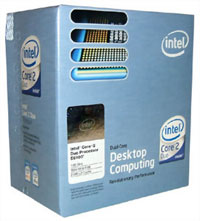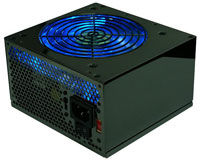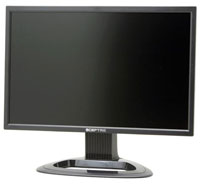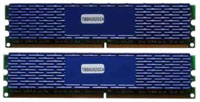Upgraded Midrange Configuration
We've covered our basic recommendations, but of course there's a lot of fine tuning that can be done. The price bracket that can be defined as being midrange is pretty large; some people feel midrange is closer to $1000 while others feel it's closer to $2000. We would say $2000 is more of a high-end configuration, but as we mentioned earlier you don't need to purchase every upgraded component when customizing your own midrange build. Here then are the upgraded midrange recommendations.
| Intel Mid-Range Performance System |
| Hardware |
Component |
Price |
Rebates |
| Processor |
Intel Core 2 Duo E6600 (2.40GHz 4MB Shared) - Retail |
$317 |
|
| Motherboard |
ASUS P5B-E (P965 775) |
$151 |
|
| Memory |
Super Talent 2x1GB DDR2-800 (T800UX2GC4) |
$268 |
|
| Video Card |
Sapphire Radeon X1950XT 256MB (100186L) |
$256 |
$30 |
| Hard Drive |
Western Digital 500GB SATA 3.0Gbps 7200RPM 16MB (Caviar SE16) |
$148 |
|
| Optical Drive |
LG Black 18X DVD+R (GSAH22N-BK) |
$36 |
|
| Case |
Lian Li PC-7B plus II |
$103 |
|
| Power Supply |
Rosewill SLI 600W (RP600V2-S-SL) |
$73 |
|
| Display |
Sceptre x22wg-Gamer 22" 5ms DVI+HDMI (1680x1050) |
$365 |
$20 |
| Sound Card |
Creative Sound Blaster X-Fi XtremeGamer 7.1 |
96 |
|
| Speakers |
Logitech Z-5300e 5.1 280W THX Speakers |
$159 |
|
| Keyboard and Mouse |
Microsoft Comfort Curve 2000 B2L-00047 |
$28 |
|
| Operating System |
Windows XP MCE 2005 (with Vista coupon) |
$115 |
|
| Bottom Line |
|
$2115 |
$2065 |
 |
As you can see, we've limited our performance upgrade to the Intel platform. AMD is still be reasonably competitive with the E6600 when using their X2 5000+, but we definitely give the edge to Intel and the prices of those two processors are about the same. A few of the less critical components stayed the same, but we've upgraded almost everything.
The upgraded processor improves clock speed over the E6300 by 28%, and the 4MB L2 cache typically adds another 5% to 15% performance depending on the application. It ends up being about 40% more processor performance for a price increase of 70%, which really isn't that bad in terms of CPU price/performance scaling.
The ASUS P5B-E motherboard isn't going to be noticeably faster than the Biostar 965PT, but it does have some extra features. The ASUS board adds FireWire support, three more internal SATA ports and one eSATA port, RAID 0/1/5/10 support, a slightly different expansion card slot arrangement, and a different onboard audio solution. The ASUS P5B-E is also one of the better overclocking motherboards, especially in its price bracket.
Along with the faster processor and upgraded motherboard, we selected some Super Talent DDR2-800 memory with 4-4-3 timings. The performance benefit of the faster memory probably isn't worth the extra $40 ($70 after OCZ rebate) unless you plan on overclocking, and we will be using this same memory on the overclocking configuration. These Super Talent DIMMs allow for up to 2.2V officially and should come close to matching the performance of many of the $400+ memory kits. Timings will likely need to be relaxed a bit more, but overall they are very good DIMMs.
 |
There are quite a few good graphics cards in the $200-$300 price range, and for the performance configuration we selected one of the faster models. The X1950 XT 256MB is nearly as fast as the full X1950 XTX in most situations, but it's priced about $100 lower. There are a few games and applications that can benefit from having 512MB of memory, but even then the performance difference is rarely more than 10% so the 40% price increase is hard to justify. Anyone interested in running a CrossFire setup would need to choose a different graphics card, as there are no 256MB X1950 XT CrossFire cards right now, but we wouldn't recommend CrossFire or SLI as a reasonable gaming solution unless you are already running at least a GeForce 8800 GTS or faster graphics card.
 |
The hard drive, power supply, and display upgrades all take the same approach: bigger is better! If you're not the type of person to fill even a 250GB hard drive, obviously the hard drive upgrade is unnecessary. The Rosewill 600W power supply is probably overkill, but users who plan on adding multiple hard drives and perhaps a second graphics card in the future probably won't feel too bad about spending an extra $10. Whether or not the Rosewill 600W is really that much better than the Fortron Source 450W is debatable, but most people have been pretty pleased with the midrange Rosewill offerings. Just be aware that they aren't particularly quiet.
 |
The 22" LCD has the same resolution as the 20" LCD in our base configuration, but it does have a few other advantages. The Sceptre x22wg-Gamer boasts a 5ms response time (versus 8ms), but more importantly it includes HDCP support and it also has an HDMI input. Acer offers a couple of similar 22" LCDs that are worth considering, and if you are primarily concerned with image quality we would rate them as being more or less equivalent to the Sceptre (most of the 22" LCDs use the same panel after all). For $50 less you can forget all about HDCP support and just get a standard LCD, or you can save $20 and still get HDCP but drop the HDMI port. Several other companies offer similar LCDs, with prices ranging from $300-$400, but if you want to get something larger than a 22" LCD the next step up will be the 23" and 24" models that cost at least twice as much. We'll save such displays for the High-End Buyer's Guides.
 |
The last two upgrades are a change of case and improved audio, neither of which are truly a critical upgrade. The Lian Li cases do look nice and they are invariably very high-quality designs, and the PC-7B Plus II has been popular for quite some time. Unlike the basic case, the Lian Li features an aluminum construction that reduces the weight and helps to avoid sharp edges on the interior. It also comes with two 120mm fans which should help to provide exceptional cooling for all but the most demanding builds. The drawback of the two fans is that they do tend to create more wind noise, but you can always unplug the front fan if that's a concern.
 |
As for the speakers, the Logitech Z-5300e speakers certainly sound better than the cheaper Logitech X-530, but they also take up more space. The subwoofer in particular is very large (as is the remote), and for many environments the sound output may be overpowering. There's also no point in investing in really nice speakers if you don't intend to use a higher-quality soundcard, which is why we've included the Creative Sound Blaster X-Fi XtremeGamer. The X-Fi will primarily help in gaming applications, but it does provide cleaner audio than onboard solutions as well. Multimedia enthusiasts might also be interested in adding a TV tuner card, in which case we would look towards either the NVIDIA DualTV, ATI Theater 650, or one of the Hauppauge offerings.
Altogether, the various performance upgrades add almost $800 to the total cost. We do feel that every one of the upgrades is justifiable, but most people probably aren't looking to spend upwards of $2000 on a new computer. This is definitely a high-end configuration rather than a midrange system, but we wanted to give a list of good potential upgrades without drifting off into long-winded debates about which upgrades are the most important. If you want a good start to a high-end computer, you can of course take this list and run with it you will be very pleased. If you want more of a middle ground, the speaker, case, motherboard, and memory upgrades are the first areas we would look to trim costs.


















43 Comments
View All Comments
KorruptioN - Friday, January 19, 2007 - link
That 500W unit is built by ATNG, the 600W PSU in the guide comes from Solytech/Deer. Two completely different OEMs. ATNG is still not regarded very highly around the Internets, but they're working on it.As for the number of DOAs being higher (which may indeed be true), what happens when the entire computer is taken out by a faulty PSU that fails catastrophically on it's secondary side? Sure they'll give you a new power supply, but you'll still be out of a functioning computer.
Operandi - Friday, January 19, 2007 - link
Rosewill has many OEMs for it's units.That unit reviewed by Jonny Guru has absolutely no bearing on the unit recomended in the article. One good Rosewill unit doesn't make the rest of them so. The only thing that matters is how the unit is built, not the sticker on the outside.
crydee - Friday, January 19, 2007 - link
I would of recommended the Corsair HX-520 for the mid-range overclocking guide it's cheaper and performs awesome. You guys saw the 620W version take on 2 8800GTXs >_<